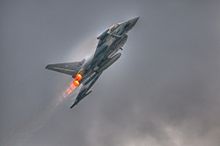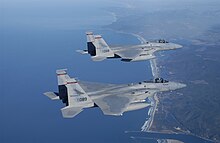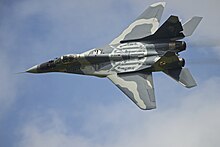| Revision as of 00:07, 7 November 2019 editJohn B123 (talk | contribs)Autopatrolled, Extended confirmed users, Page movers, New page reviewers194,455 edits Importing Wikidata short description: "Fighter aircraft classification tasked with combating other aircraft to gain control of the air" (Shortdesc helper)← Previous edit | Revision as of 20:33, 12 November 2019 edit undo130.89.162.106 (talk) →List of active air superiority fighters: There are many variants of modern mig-29, not just UPG which is only an export for indiaNext edit → | ||
| Line 42: | Line 42: | ||
| |1976 | |1976 | ||
| |- | |- | ||
| |Soviet Union/Russia |
|Soviet Union/Russia | ||
| |] | |] | ||
| |] | |] | ||
| |1982 | |1982 | ||
| |- | |- | ||
Revision as of 20:33, 12 November 2019
Fighter aircraft classification tasked with combating other aircraft to gain control of the air| This article needs additional citations for verification. Please help improve this article by adding citations to reliable sources. Unsourced material may be challenged and removed. Find sources: "Air superiority fighter" – news · newspapers · books · scholar · JSTOR (May 2008) (Learn how and when to remove this message) |






An air superiority fighter is designed for entering and seizing control of enemy airspace as a means of establishing complete dominance over the enemy's air force. Air superiority fighters are designed primarily to effectively engage enemy fighters, more than other types of aircraft, although some may have a secondary role for air-to-ground strikes.
Evolution of the term
During World War II and through the Korean War, fighters were classified by their role: heavy fighter, interceptor, escort fighter, night fighter, and so forth. With the development of guided missiles in the 1950s, design diverged between fighters optimized to fight in the beyond visual range (BVR) regime (interceptors), and fighters optimized to fight in the within visual range (WVR) regime (air superiority fighters). In the United States, the influential proponents of BVR developed fighters with no forward-firing gun, such as the original F-4 Phantom II, as it was thought that they would never need to resort to WVR combat. These aircraft would sacrifice high maneuverability, and instead focus on other performance characteristics, as they presumably would never engage in a dogfight with enemy fighters.
Lessons in combat
Combat experiences during the Vietnam War proved BVR proponents wrong. Owing to restrictive rules of engagement and the failings of 1960s missile and radar technology, air combat often devolved into close-range dogfights. The lessons from this conflict spurred a rethinking of design priorities for fighter aircraft and development of the U.S. Navy's TOPGUN and the U.S. Air Force's Red Flag programs to teach pilots the lessons of dogfighting.
The first air superiority fighters
After lessons learned from combat experiences involving modern military air capacity, the U.S. Navy's VFAX/VFX and U.S. Air Force's F-X (Fighter Experimental) reassessed their tactical direction which resulted in the U.S. Navy's F-14 Tomcat and US Air Force's F-15 Eagle. The two designs were built to achieve air superiority and significant consideration was given during the development of both aircraft to allow them to excel at the shorter ranges of fighter combat. Both aircraft also serve as interceptors due to their high maximum speed.
By contrast, the Soviets (and the succeeding Russian Federation) developed and continue to operate separate types of air superiority (MiG-29, Su-27) and interceptor (MiG-25, MiG-31) fighters.
Evolution of secondary ground-attack capability
For the US Navy, the F-14 Tomcat was initially deployed solely as an air superiority fighter (plus fleet defense interceptor and tactical aerial reconnaissance). By contrast, the multirole F/A-18 Hornet was designed as strike fighter while having only enough of an edge to defend itself against enemy fighters if needed. While the F-14 had an undeveloped secondary ground attack capability (with a Stores Management System (SMS) that included air-to-ground options as well as rudimentary software in the AWG-9), the Navy did not want to risk it in the air-to-ground role at the time, due to its lack of proper defensive electronic countermeasures (DECM) and radar homing and warning (RHAW) for overland operations, as well as the fighter's high cost. In the 1990s, the US Navy added LANTIRN pods to its F-14s and deployed them on precision ground-attack missions.
The F-15 Eagle was envisioned originally as an air superiority fighter and interceptor under the mantra "not a pound for air-to-ground". However, the F-15C can carry "dumb" and GPS guided bombs, such capabilities which were first used by Israeli Air Force. In fact, the basic airframe proved versatile enough to produce a very capable strike fighter, the F-15E Strike Eagle. While designed for ground attack, it retains the air-to-air lethality of the original F-15. Similarly, the F-16 Fighting Falcon was also originally designed as an air superiority fighter but has since evolved into a successful all-weather multirole aircraft.
1990s to present
Since the 1990s, with air superiority fighters such as the F-14 and F-15 pressed into the strike role and/or having a strike derivative, the lines between air superiority fighters and multirole fighters has blurred somewhat.
With the retirement of the F-14 Tomcat, the US Navy has pressed its F/A-18 Hornet and its upsized derivative, the F/A-18E/F Super Hornet, into the air superiority role, despite the Hornets being originally designed as multirole strike fighters.
List of active air superiority fighters
| Country | Manufacturer | Aircraft | Introduced |
|---|---|---|---|
| United States | McDonnell Douglas | F-15 Eagle | 1976 |
| Soviet Union/Russia | Mikoyan | MiG-29 | 1982 |
| Soviet Union/Russia | Sukhoi | Su-27 | 1985 |
| Russia/India | Sukhoi/Hindustan Aeronautics Limited | Su-30MKI | 2002 |
| European Union | Eurofighter | Typhoon | 2003 |
| United States | Lockheed Martin | F-22 Raptor | 2005 |
| Russia | Sukhoi | Su-35S | 2014 |
| China | Chengdu Aerospace | J-20 | 2017 |
See also
Notes
- Davies, Steve. (2005). F-15C Eagle Units in Combat. Osprey Publishing Ltd. pp. 6-9. ISBN 978-1-84176-730-7.
- Spick, Mike. (1985). Modern Fighting Aircraft: F-14. Arco Publishing Inc. p. 8. ISBN 0-668-06406-4.
- Gillcrist, Paul T. (1994). Tomcat! The Grumman F-14 Story, Schiffer Publishing, pp. 10, 195. ISBN 0-88740-664-5 .
- "F-14 Tomcat fighter fact file." United States Navy, 5 July 2003. Retrieved: 20 January 2007.
- Hallion, Dr. Richard P. "A Troubling Past: Air Force Fighter Acquisition since 1945." Airpower Journal, Winter 1990. Retrieved: 1 September 2011.
- Jenkins 1998, pp. 35–36.
- "Lockheed Martin to deliver 4,500th F-16 fighter". McClatchy DC. 2012-04-02. Retrieved 13 September 2014.
External links
| Modern military aircraft types and roles | |||||
|---|---|---|---|---|---|
| Types | |||||
| Roles |
| ||||